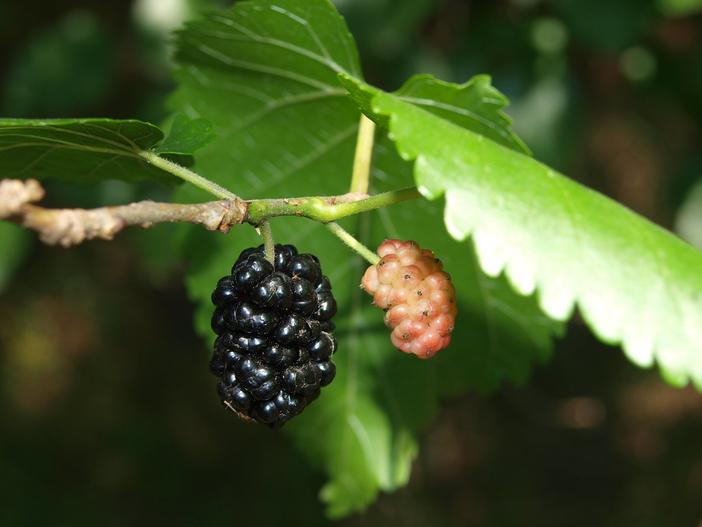Black Mulberry
(Morus nigra)
Black Mulberry (Morus nigra)
/
/

szántó
PDM 1.0
Image By:
szántó
Recorded By:
Copyright:
PDM 1.0
Copyright Notice:
Photo by: szántó | License Type: PDM 1.0 | License URL: https://creativecommons.org/publicdomain/mark/1.0/ | Uploader: szántó | Publisher: Flickr











































Estimated Native Range
Summary
Morus nigra, commonly known as black mulberry, is a deciduous tree native to the woodland margins, scrub areas, and rocky hillsides of southwestern Asia. It typically grows up to 39 feet (12 meters) tall and is known for its broad, heart-shaped leaves and dense, rounded canopy. The black mulberry produces dark purple, sweet-tasting fruit that is highly regarded for its rich flavor and nutritional content, particularly its high levels of anthocyanins. The fruiting season is in late summer, and the berries are often used in culinary applications such as jams, pies, and sherbets. In addition to its fruit, Morus nigra is valued for its attractive form and foliage, making it a suitable choice for ornamental plantings in gardens and parks.
Black mulberry trees are adaptable to a variety of soil types, though they prefer well-drained, loamy soils. They are drought-tolerant once established and can thrive in full sun to part shade conditions. While they are relatively low-maintenance, they can be susceptible to pests such as the whitefly and diseases like root rot if grown in poorly drained soils. Due to its potential invasiveness, it is important to consult local guidelines before planting Morus nigra outside its native range. It can spread through root suckers and self-seeding, potentially displacing native vegetation.CC BY-SA 4.0
Black mulberry trees are adaptable to a variety of soil types, though they prefer well-drained, loamy soils. They are drought-tolerant once established and can thrive in full sun to part shade conditions. While they are relatively low-maintenance, they can be susceptible to pests such as the whitefly and diseases like root rot if grown in poorly drained soils. Due to its potential invasiveness, it is important to consult local guidelines before planting Morus nigra outside its native range. It can spread through root suckers and self-seeding, potentially displacing native vegetation.CC BY-SA 4.0
Plant Description
- Plant Type: Tree
- Height: 30-40 feet
- Width: 35-50 feet
- Growth Rate: Moderate
- Flower Color: N/A
- Flowering Season: Spring, Summer
- Leaf Retention: Deciduous
Growth Requirements
- Sun: Full Sun
- Water: Medium
- Drainage: Fast, Medium
Common Uses
Bee Garden, Bird Garden, Edible*Disclaimer: Easyscape's listed plant edibility is for informational use. Always verify the safety and proper identification of any plant before consumption., Low Maintenance, Street Planting
Natural Habitat
Woodland margins, scrub areas, and rocky hillsides of southwestern Asia
Other Names
Common Names: Morus Nera , Morera Negra
Scientific Names: Morus nigra , Morus atrata , Morus cretica , Morus laciniata , Morus nigra var. dentata , Morus nigra var. laciniata , Morus nigra var. lobata , Morus nigra var. microcarpa , Morus nigra var. scabra , Morus petiolaris
GBIF Accepted Name: